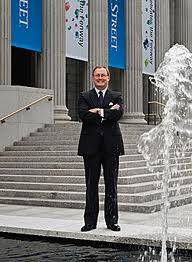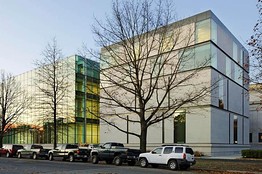 In many corners of the art world, the cultural event of the fall season will be the opening on Nov. 20 of the much-awaited Art of the Americas wing at the Museum of Fine Arts in Boston.
In many corners of the art world, the cultural event of the fall season will be the opening on Nov. 20 of the much-awaited Art of the Americas wing at the Museum of Fine Arts in Boston.
In late August, I hustled up there, and was surprised to see most of the 53 galleries in the new wing (pictured below) largely installed. (I’ve talked with some museums that, two days before the opening of an expansion, aren’t nearly finished.) This is a well-run museum.
I spent time walking around the wing with, and then talking to, Malcolm Rogers, the museum’s director, for a Cultural Conversation that will be published in tomorrow’s Wall Street Journal. The article is about the wing, yes, but also about Rogers’s philosophy for running a museum like MFA.
It’s a rather positive story, and as they say, who’da thunk? Let me recall some history, and add a few things that didn’t make it into the piece.
When Rogers came here in fall, 1994 from Britain to take the job, few people wanted it — despite the museum’s fabulous collections. The museum was adrift, with financial difficulties compounding its problems. Attendance was down, and so were contributions. Rogers got off to a controversial start, cutting staff and exhibitions, and giving a speech called “The M.F.A. Is 125 Years Old: Are We to Hold a Birthday Party or a Wake?”
It worked — finances, attendance, and exhibitions improved (though for some he was accused of dumbing down) — but it wasn’t enough: In 1999, he restructured again, sacking staff like Anne Poulet — who later landed very well as director of the Frick Collection and sending fear through the curatorial community. His move was dubbed the Boston Massacre, though he said he was simply breaking up fiefdoms and making the museum act as one.
There’s an element of truth in both sides, though I think even Rogers’s backers would concede that the way he did things in those early years was rather brutal.
 But in hindsight, Rogers has unquestionably made the MFA a better place. He may have saved it.
But in hindsight, Rogers has unquestionably made the MFA a better place. He may have saved it.
Now, maybe he has mellowed. Maybe his results are too good to question. He explains himself well — saying, for example, that he early on courted controversy with some exhibitions, but now doesn’t have to. He still wants to stretch the boundaries of art: “My notion is that every five or six exhibitions, we do something new,” he told me. He also cited his hiring of a jewelry curator — which he thinks will be copied.
For the new wing, he did not make the mistake so many museum directors have — getting a museum with what he calls “a showy outside” but one that’s bad for the art inside. And he raised money for the endowment ($159 million) as part of the wing’s overall $504 million campaign — not waiting till afterward, as so many other museums did. Bravo.
This fall, he’ll bask in glory, deservedly, I think. What I saw in the new wing looked wonderful, though I reserve final judgment until I see the final product.
And then, if he does what he says he’ll do in my article, he’ll get back to work, because running a great museum is like maintaining a bridge — as soon as you finish painting it, you start all over at the opposite end.
Photo Credit: Courtesy of MFA, Boston
